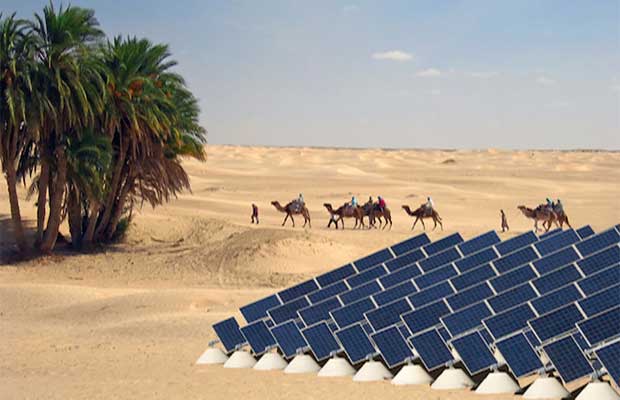The Saudi government has planned green initiatives on increasing Saudi Arabia’s reliance on clean energy, offsetting emissions, and protecting the environment in order to achieve the vision 2030.
The government’s significant steps taken towards the development of renewable energy projects, include– the establishment of the Saudi Renewable Energy Project Development Office to oversee the development of renewable energy projects and the launch of the Solar Energy Plan, aiming to install 27.5 GW of solar capacity by 2030. Besides this, in a step towards cutting down carbon emissions, Saudi plans to launch the greenhouse gas certificates market in 2023.
Looking a year back, in 2021, the Saudi Green Initiative provided the impetus needed to increase the share of renewable energy to 50% of its primary energy mix while producing the other 50% from natural gas by 2030.
Also the market reports revealed that with the view to achieve `Vision 2030’,Saudi is expected to develop more than 40 GW of solar photovoltaic (PV) capacity and 2.7 GW of Concentrated Solar Power (CSP) by 2030. Moreover, the Renewable Energy Project Development Office (REPDO), established in 2017, is working towards achieving the goals of the National Renewable Energy Program (NREP) in line with Vision 2030.
As per reports from International Renewable Energy Agency (IRENA), Saudi Arabia’s total solar installed capacity stood at 14 MW in 2012, which rose to 439 MW at the end of 2021. Solar PV has been the most significant share in total solar energy capacity, with 389 MW in the country, accounting for more than 88% of the total solar energy.
Further, the market reports revealed that in September 2022, Saudi Power Procurement Company launched five projects to generate electricity as part of the fourth phase of the Ministry of Energy’s National Renewable Energy Program. The projects include three wind projects and two solar energy-based projects. The two solar energy projects in Al Hinakiyahand Tabarjalwould have a capacity of about 1,100 MW and 400 MW, respectively.
Last year, Saudi Arabia awarded solar power projects with a total capacity of 1 GW to the Saudi Power Procurement Company that signed a 25-year power purchase agreement for a 700 MW plant with Ar RassSolar Energy Company. The project is estimated to be around USD 450 million. Under the third round of Saudi Arabia’s National Renewable Energy Programme(NREP),The company also signed MoU for a 300 MW Saad photovoltaic (PV) solar project with Jinko Power, a Chinese solar company,which is expected to be inbuilt in the Saad region in Riyadh. The estimated cost of project is ~USD 213 million. It is a 25-year power purchase agreement (PPA) with Saudi Power Procurement Company (SPPC) with the tariff of SAR 5.56255/kWh for the project.The construction is scheduled to spread over 2022 to 2023.
In addition,the ambitious National Renewable Energy Program (NREP) aims to install 27.3 GW of renewable energy by 2024 and 58.7 GW by 2030, including 40 GW of PV and 2.7 GW of CSP.This will provide opportunities for both the private and public sectors to capitalise on the country’s shift towards a cleaner and more diversified energy mix.
The year 2022(June) also witnessed China Energy Engineering Group, Guangdong Power Engineering Company (GPEC) being awarded the LONGia module supply contract for the 400 MW (DC) Rabigh Solar PV IPP project in Saudi Arabia, located in Rabigh Industrial City in the western Makkah Province of the country.
As per reports,Saudi Arabia is expected to add 10 GW of renewable capacity between 2022 and 2027, with solar PV leading the market.The four procurement mechanisms for the same include : competitive auctions, unsolicited bilateral utility contracts, corporate power purchase agreements (PPAs), and state-owned projects. The market survey suggested upward growth for this due to progress made under all four business models and also due to the announced climate commitments during COP27.
The total generating capacity of the National Renewable Energy Program projects in Saudi is expected to reach ~56 million megawatt-hours, with clean electricity generation. The capacity is expected to increase around 58.7 GW by 2030. Out of this, 40 GW will come from solar energy, 16 GW from wind energy, and 2.7 GW from other renewables.
Though a fossil fuel rich country, yet Saudi Arabia is actively working to increase the use of renewable energy as part of its goal to reduce reliance on fossil fuels and achieve net zero carbon emissions by 2060.
The government has taken steps to improve legislation such as passing the Private Sector Participation Law in March 2021 to create a better framework for both foreign and domestic investors in the kingdom’s privatisation programmes and public‑ private partnerships.
Majorly,the utility-scale market in Saudi Arabia plays a major role in the Middle East and North Africa region, with annual additions of approximately 1-15 GW.
Under the Saudi Arabia Vision 2030, the Kingdom seeks to reach 27.3 GW of renewable power capacity by 2023, including 20 GW of solar photovoltaic (PV) and 7 GW of wind power, and aims at 58.7 GW by 2030, with solar accounting for 40 GW at the end of the decade.
As per experts, with diversification in energy mix, Saudi has the potential to become more competitive and achieve the lowest prices for renewable energy projects.


